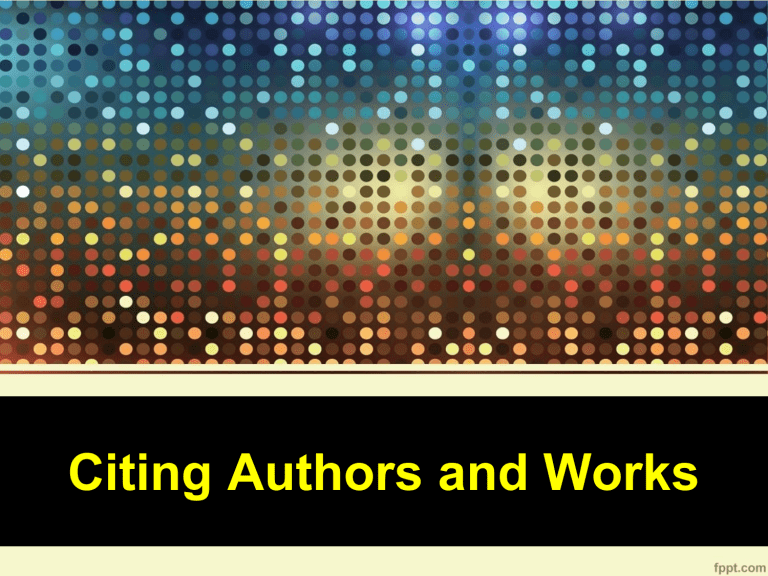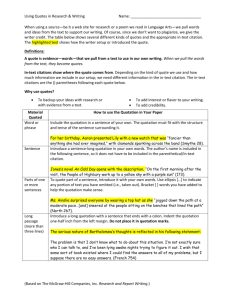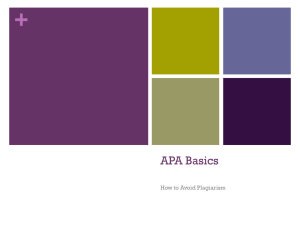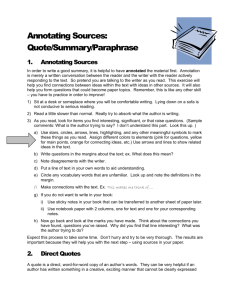Diapositiva 1

Citing Authors and Works
INTERNET
With an inspiring message that spans across time and through generations, Hotel
Rwanda is the type of movie that promotes change.
Instead of historically telling the story of
Rwanda, George takes a chance in recounting the life of a local hero,
Paul Rusesabagina (Don Cheadle), and the risks he took to save the lives of many. Hotel Rwanda starts where the tragedy begins.
What is plagiarism?
Plagiarism is the use of another person ’s ideas or words without giving them the proper credit.
Plagiarism can occur when you use someone else ’s exact words without giving them credit, taking credit for someone else ’s ideas , or even presenting your own past work as a new idea .
TYPES
of
PLAGIARISM
www.plagiarism.org
SOURCES NOT
CITED
The writer turns in another ’s work, word-for-word, as his or her own work.
THE GHOST WRITER
The writer copies significant portions of text straight from a single source, without alteration.
THE PHOTOCOPY
The writer tries to disguise plagiarism by copying from several different sources, tweaking the sentences to make them fit together while retaining most of the original phrasing.
THE POTLUCK PAPER
Although the writer has retained the essential content of the source, he or she has altered the paper ’s appearance slightly by changing key words and phrases.
THE POOR DISGUISE
The writer takes the time to paraphrase most of the paper from other sources and make it all fit together, instead of spending the same effort on original work.
THE LABOR OF
LAZINESS
The writer “borrows” generously from his previous work, violating policies concerning the expectation of originality adopted by most academic institution.
THE SELF-STEALER
SOURCES CITED
(BUT STILL
PLAGIARIZED)
The writer mentions an author ’s name for a source, but neglects to include specific information on the location of the material referenced.
This often masks other forms of plagiarism by obscuring source locations.
THE FORGOTTEN
FOOTNOTE
The writer provides inaccurate information regarding the sources, making it impossible to find them.
THE MISINFORMER
The writer properly cites a source, but neglects to put in quotation text that has been copied verbatim, or close to it. Although attributing the basic ideas to the source, the writer is falsely claiming original presentation and interpretation of the information.
THE TOO-PERFECT
PARAPHRASE
The writer properly cites all sources, paraphrasing and using quotations appropriately. The catch? The paper contains almost no original work!
THE RESOURCEFUL
CITER
The writer properly quotes and cites sources in some places, but goes on to paraphrase other arguments from those sources without citation. This way, the writer passes off the paraphrased material as his own.
THE PERFECT CRIME
What is APA?
The American Psychological Association
(APA) citation style is the most commonly used format for manuscripts in the Social Sciences . It regulates:
STYLISTICS, IN-TEXT CITATIONS, and REFERENCES
Why Use APA Format?
• Allows readers to cross-reference your sources easily
• Provides consistent format within a discipline
• Gives you credibility as a writer
• Protects yourself from plagiarism
Paraphrasing
PARAPHRASING
• Paraphrasing means that you expressed the author ’s information or ideas in your own words and have given that person credit for that information or idea.
• You can prevent plagiarism by closing the document and restating the idea in your own words.
PARAPHRASING
Original Passage: “Signed into law in
January 2002 by President George W.
Bush, the No Child Left Behind (NCLB)
Act signaled the nation ’s most sweeping education reform of federal education policy in decades ” (Smith, 2008. p. 212).
PARAPHRASING
Enacted into law in 2002 by President
Bush, the No Child Left Behind Act signaled the most sweeping education reform of U.S. educational policy in decades.
PARAPHRASING
According to Smith (2008), the No Child
Left Behind Act (NCLB) provided the most all-encompassing reform in U.S. education in almost half a century.
PARAPHRASING
The No Child Left Behind Act (NCLB)
Act provided the most all-encompassing reform in U.S. education in almost half a century (Smith, 2008).
In-text citation
In-text Citation (Direct Quote)
When you directly quote an author, you need to put the exact words of the author in quotation marks or follow the rules for a block quotation.
Include the exact spelling and interior punctuation of the borrowed words.
In-text Citation (Direct Quote)
The author, year of publication, and page number(s) or paragraph number for non-paginated materials are always included in the text and a reference citation is included in the reference list.
McPherson (2007) coined the phrase
“goblet of motivation” (p. 71).
In-text Citation (Direct Quote)
Regular Quotes are used when the quote is less than 40 words.
McPherson (2007) coined the phrase
“goblet of motivation” (p. 71).
In-text Citation (Direct Quote)
• Keep the author and year of publication together.
• Use quotation marks to identify the exact words of the author.
• Include the page number in parentheses immediately after the direct quote.
• Place the period after the parentheses.
Single author
APA Style gives prominence to the date of a publication. In-text citations use the author's last name and the date, separated by a comma, as a brief reference in the text of the article to refer the reader to complete information in the reference list.
Example:
“APA style is a difficult citation format for first-time learners ” (Jones, 1998, p. 199) .
Single author
If the author's name is mentioned in the narrative , then only the date need be given:
Example:
Jones (1998) described APA as “a difficult citation format for first-time learners ” (p.
199) .
Two authors
Always use both names every time they are referred to in the text. Use the ampersand
(&) to connect the names in the parentheses, but spell out "and" in the running text.
Examples:
(Parker & Mokhesi-Parker, 1998)
Parker and Mokhesi-Parker (1998) in examining institutional design and function …
Three to five authors
Cite all the authors in text the first time a reference occurs; in subsequent citations, include only the surname of the first author followed by et al.
Examples:
(Parker, Mokhesi-Parker, AuthorC,
AuthorD & AuthorE, 1998)
(Parker et al., 1998)
Six or more authors
Cite in text only the surname of the first author followed by et al. and the year for the first and subsequent citations.
Examples:
Parker et al. (1998)
(Parker et al., 1998)
Anonymous author
Examples:
From an anonymous source (1998)
(Anonymous, 1998)
Quote from non-paginated material
Examples:
Winkowski (2007) stated, “The research is unreliable ” (Conclusion section, para.
4).
From the conclusion section of paragraph 4 of (book title), (2007).
Short quotation (More examples)
According to Jones (1998), "Students often had difficulty using APA style, especially when it was their first time" (p. 199).
Jones (1998) found "students often had difficulty using APA style" (p. 199); what implications does this have for teachers?
Block quote (long quotation)
Block quotes are used for quotes of more than
40 words.
Block quote (long quotation)
• Indent the block quote five spaces or half an inch.
• Do not use quotation marks.
• Double space the quote unless your school has a rule about single spacing block quotes.
• Do not include any additional lines or spaces before or after the block quote.
• Notice that in block quotes, the period goes before the parentheses, not after.
Block quote (long quotation)
Students at Nova Southeastern University have faced challenges in learning how to use APA formatting. When discussing the challenges, Strunk (1922) stated:
Use quotes around an article title or book chapter, but italicize the title of a book, journal, brochure, or report when used in the body of the paper. Use a short title in the parenthetical citation or complete title if the title is short. NOTE Non-periodical titles like books and book titles have all the important words capitalized in the text citations, but these same book titles do not have all the important words capitalized in the reference list. (p.342)
Special case
Boyle (1998a, 1998b, 1998c) found in three separate studies that the rats had higher stress hormone levels after exposure.
The three studies were done in 1998 and each was published separately that year. To avoid confusion, each study will be designated by a different letter – a, b, c, etc. Items are listed in the reference section alphabetically by title.
Personal Communication
According to T. Decano (personal communication, August 15, 2011) , the school is ready for e-books.
The e-books are ready for implementation (T. Decano, personal communication, August 15, 2011).
Special case
Strunk (1922) mentioned in his article to “[u]se quotes around an article title or book chapter, but italicize the title of a book…[u]se a short title in the parenthetical citation or complete title if the title is short…” (p.342).
Bibliography Page
How to create a BIBLIOGRAPHY PAGE
• Center the title (Bibliography or
References) at the top of the page. Do not bold it.
• Double-space reference entries*.
• Flush left the first line of the entry and indent subsequent lines.
• Order entries alphabetically by the author ’s surnames.
How to create a BIBLIOGRAPHY PAGE
• Invert authors’ names (last name first followed by initials: “Smith, J.Q.”).
• Capitalize only the first letter of the first word of a title and subtitle , the first word after a colon or a dash in the title , and proper nouns . Do not capitalize the first letter of the second word in a hyphenated compound word.
How to create a BIBLIOGRAPHY PAGE
• Capitalize all major words in journal titles .
• Italicize or underline titles of longer works such as books and journals .
• Do NOT italicize, underline, or put quotes around the titles of shorter works such as journal articles or essays in edited collections .
Sample Entries
Book with a single author
Austin, J. H. (1998). Zen and the brain:
Toward an understanding of meditation and consciousness .
Cambridge, MA:
MIT Press.
Strunk, W., Jr. (1979). The elements of style (3 rd ed.). New York: Macmillan.
Book with two authors
Strunk, W., Jr., & White, E.B. (1979). T he elements of style (3 rd ed.). New York:
Macmillan.
Book with multiple authors
Calarco, M., San, K., & Atterton,
P.(2009). Animal philosophy: Essential readings in continental thought. New
York: Continuum.
Edited book
Ickes, W. (Ed.). (1998). Empathic accuracy .
New York, NY: Guilford
Press.
Book with corporate authors
World Bank. (2004). Gender and development in the Middle East and
North Africa: Women in the public sphere. Washington, DC: Author.
Section from a book
Jeffrey, I. (2002). Introduction. In B.
Savelev, Secret city: Photographs from
Peru ( pp. 8-12). New York: Thames and Hudson.
CD-ROM
King, M.L., Jr.(1963). I have been to the mountaintop. Infamous American speeches
[CD-ROM]. Retrieved from Oryx Press database [1996, November 8].
Web site
You CANNOT CITE a WEB SITE. You have to be specific by citing the WEB PAGE or a particular WEB LOG.
Web page
Freidman, G. (2003). The troubled tenses in
Chaucer ’s works. In Wikipedia . Retrieved
February 6, 2010, from http://www.wikipedia.com/chaucer/
Web page
Centers for Disease Control and Prevention.
(2009). 2009 H1N1 Flu ("Swine Flu") and
You. Retrieved February 6, 2010, from http://www.cdc.gov/h1n1flu/qa.htm
Blog post
McAdoo, T. (2009, September 10). Use of first person in APA style [Web log message].
Retrieved May 7, 2010, from http://blog.apastyle.org/
Journal
Burger, J., Gochfeld, M., Jeitner, C., Burke, S.,
Stamm, T., Snigaroff, R., ... Weston, J.
(2007). Mercury levels and potential risk from subsistence foods from the
Aleutians. Science of the Total Environment ,
384, 93-105. doi:10.1016/j.scitotenv.2007.05.004
*doi = DIGITAL OBJECT IDENTIFIER
Online journal
Killingbeck, D. (2001). The role of television news in the construction of school violence as "moral panic" [Electronic Version]. Journal of Criminal Justice and Popular Culture , 8 ,
186-202. Retrieved October 30, 2001, from http://www.albany.edu/scj/jcjpc/vol8is3/killing beck.html
Newspaper article
Young, J. (2003, February 14). Prozac campus:
More students seek counseling and take psychiatric medication. The Philippine Star, pp. A37-38.
Magazine article
Henry, W. A., III (1990, April 9). Beyond the melting pot. Time , 135 (4), 28-31.
Thesis
Johnson, S. (2004). Financial variables and merger premiums: Evidence from bank mergers .
Retrieved from Dissertations and
Theses database.(AAT 3025476)
Johnson, S. (2004). Financial variables and merger premiums: Evidence from bank mergers [Unpublished thesis] .
Retrieved from Dissertations and Theses database.(AAT 3025476)
Song recording
Desmond, P. (1959). Take five [recorded by
Dave Brubeck Quartet]. On Time out [CD]
New York: Columbia. (1987)
Film
Jarre, K., Carr, P. (Producers), & Sommers, S.
(Director). (2004). The mummy [Motion
Picture]. MCA Universal Home Video.
Stage play
Atlantis Productions (Producer), & Garcia, B.
(Director). (2011). Next to normal [Stage
Play]. Makati: Carlos P. Romulo Auditorium.



